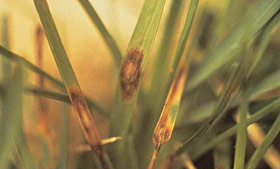Leaf Spot Disease: Spring Leaf Spot, Drechslera poae and D. siccans, and Summer Leaf Spot, Bipolaris sorokiniana

From Leaf Spot and Melting-out (crown and root rot) Diseases, Penn State Center for Turfgrass Science.
IPM Steps to Reduce Leaf Spot Disease
1. Sample for Pest
Confirm the presence of leaf spot disease before you treat.
Where to find it while inspecting: Find on turfgrass blade in humid weather. Look for leaf spots that begin as small red to purple spots/ovals and later develop dead centers (brown spots or “eye spots”).
2. Proper ID
Is it leaf spot?
Size and Appearance: Can begin as small spot on grass blade and spread along entire blade, killing it. Once leaf spot fungi enters turf crown, entire plant may die (melting out disease).
3. Learn the Pest Biology
What is the life cycle of leaf spot disease?
Life Cycle: Leaf spot disease fungi are present in turf and soil, but are only active in specific weather conditions of moisture and temperature (humidity-dependent). In optimal situation, fungi enters turfgrass blade where they find damage, such as a tear from dull mower blades. Brown spots appear and expand and if spreading far enough will blight or kill the blade.
Preferred Food Sources: Obtain nutrients by the breakdown of organic matter.
Preferred Habitat: Moist, humid conditions in turf.
4. Determine Threshold
How much leaf spot disease is too much?
Threshold: Dependent on weather conditions and susceptibility of turf. High end turf that is stressed, cut low and fertilized often is more susceptible, as are certain species such as Kentucky bluegrass.
5. Choose Tactics
Creating a healthy soil condition and understanding turfgrass’s needs is the first step in reducing turf pests. What can I do to treat, reduce, or prevent leaf spot disease?
Best Management Practices: Keep mower blades sharpened, do not mulch grass cuttings back in when weather conditions make disease likely, beware of spreading disease by mower or foot traffic when encountering an active infestation, avoid excessive nitrogen applications in spring, water infrequently and deeply (rather than daily light waterings), reduce leaf wetness periods by watering in morning, not evenings, mow high to avoid plant stress, reseed areas with repeated problems with newer cultivars bred to be resistant.
Treatment Methods: In extreme conditions, fungicides may be an option where allowed. Note: effectiveness depends on coating the leaf surface, and types of product should be rotated if application is needed again in the future.
6. Evaluate
Was the tactic successful? Record the date pests were first noted, and the tactic you used, and its success. Use one of our RECORD KEEPING tools.
For More Information:
Penn State Plant Science: Leaf Spot and Melting-out (crown and root rot) Diseases
Remember:
When a pesticide application is necessary, all necessary and required precautions are taken to minimize risk to people and the environment and to minimize risk of pesticide resistance or pest resurgence. Pesticide use in your school may be prohibited or regulated by local policies or state and federal regulations. Risk reduction methods can include, but are not limited to, spot-treatment, the use of gel or paste bait formulations placed in inaccessible locations, injection into a crack or crevice, and other methods that reduce potential exposure.